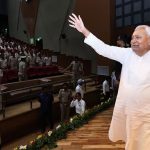This Lethal Lottery
Forget the howling majority, death penalty is a denial of individual rights
 Suhrith Parthasarathy
Suhrith Parthasarathy
 Suhrith Parthasarathy
Suhrith Parthasarathy
 |
28 Feb, 2014
|
28 Feb, 2014
/wp-content/uploads/2015/11/deathpenalty-1.jpg)
Forget the howling majority, death penalty is a denial of individual rights
CHENNAI ~ On 18 February, the Supreme Court of India ordered the commutation to life imprisonment of the death sentences previously awarded to three individuals for conspiring and murdering the former Indian Prime Minister Rajiv Gandhi. These commutations, in V Sriharan vs the Union of India, were ordered on the singular ground that the President of India had dismissed petitions for mercy filed by the three convicts after apparently ruminating on their pleas for more than 11 years.
The President, who is required to act on the advice of his council of ministers, has been given express constitutional power to pardon any person sentenced to death. But when petitioned to exercise this power, the President, according to the Supreme Court, must act in a fair and just manner. This entails a duty to dispose petitions for mercy filed by convicts on the death row within a reasonable time. In this case, the President’s failure to do so, the court held, was tantamount to a violation of the prisoners’ fundamental rights, according them a concomitant right to have their death sentences commuted to life imprisonments.
The decision in Sriharan appeals to our deepest sentiments of mercy and compassion. Some values are so important that mere majoritarian impulses cannot be an excuse to let them wither. But on closer examination, the Supreme Court’s judgment coupled with the rest of its most recent decisions on the death penalty, which seek to purportedly humanise capital punishment, while welcome, also reflect the court’s fractured approach in evolving the country’s rights-jurisprudence. If anything, these decisions show us unequivocally why the court, as a counter-majoritarian institution, ought to reconsider the constitutional and moral validity of the death penalty.
India had a de facto unofficial moratorium in place on capital punishment for nearly a decade commencing 2004. The Supreme Court’s mandate in Bachan Singh vs State of Punjab (1980) that the penalty ought to be awarded only in the ‘rarest of rare’ cases was interpreted with renewed vigour amid a general penological confusion over the penalty’s efficacy; the State, it seemed, would be consigned to re-thinking its philosophy on punishments.
In this period, the Supreme Court had held that its own failure in determining precisely when the death penalty ought to be awarded, combined with a lack of legislative mandate, created a wave of uncertainty in decisions rendered by the lower judiciary. What’s more, the court had admitted during the period that the award of the death penalty is subjective and ‘depends a good deal on the personal predilection of the judges constituting the bench’. This opinion, rendered in Swamy Shraddananda vs State of Karnataka, was an express acknowledgement of the vagaries of India’s criminal justice system. It should have represented the basis for the State to review the rationality of capital punishment. Instead, prompted by a change in President and a public baying for blood, the unofficial moratorium on executions was lifted in November 2012.
Ajmal Kasab, convicted of carrying out the terror attacks in Mumbai in 2008, was hanged to death in virtually complete secrecy days after President Pranab Mukherjee had rejected a petition for clemency filed by Kasab. In a similarly clandestine proceeding labelled ‘Operation Three Star’ on 9 February 2013, Afzal Guru, convicted of offences under both the Indian Penal Code and Prevention of Terrorism Act for carrying out the December 2001 attack on Indian Parliament, was executed with no prior notice to his family. What’s more, he was hanged within a week of the President’s decision to deny his petition for mercy, which the Home Ministry had grazed on for more than six years. The rejection of the petition was kept secret with the obvious intention of evading further judicial scrutiny. After all, a delay of such magnitude without reason, as the Supreme Court had previously held, was the equivalent of punishing a person with both death and imprisonment for the same offence.
The strongest argument against capital punishment is its irrevocability; it flickers all over the morbid execution of Afzal Guru. In January this year, similar cases of delay by the President in disposing mercy petitions led to commutations by the Supreme Court in Shatrughan Chauhan vs Union of India. Had Afzal Guru been given time to challenge the rejection of his mercy petition, it is quite conceivable that he would have been accorded the same standards of due process applied to the petitioners in Chauhan.
Here, the court held, in consonance with general international standards, that to keep a convict on death row, for years on end, chewing over the decision of his or her plea for clemency, was an act of torture. This not only violated the convict’s most essential rights, but it also demanded the commutation of his or her sentence to one of life imprisonment. It is this decision in Chauhan that ultimately served as a binding precedent when the Supreme Court decided on the petitions filed by those convicted of murdering Rajiv Gandhi this month.
There were two primary legal issues called into question in Chauhan, which decided a batch of 12 writ petitions filed by, or on behalf of, prisoners whose clemency petitions were rejected after they had spent several years on death row. One was whether the Supreme Court could judicially review decisions of the President and the Governors of various states made under constitutionally sanctioned powers of pardon. And the second was whether the delay in execution, wrought by a concomitant delay in disposing mercy petitions, constituted a valid ground for commutation of death sentences. The Supreme Court answered both questions in the affirmative.
Articles 72 and 161 of the Indian Constitution respectively give the President and the Governors of states a power to pardon prisoners. This includes the authority to commute to sentences of life imprisonment those previously consigned to death row. In Kehar Singh vs Union of India (1989), the Supreme Court held that the power vested in the President under Article 72 was ‘a constitutional responsibility of great significance, to be exercised when occasion arises in accordance with the discretion contemplated by the context’. In effecting this responsibility, the court held, the President could examine the record of evidence of the criminal case and determine for him or herself whether the case deserves a grant of relief under the power vested in him by Article 72.
The court, here, did not decide on the merits of the President’s decision in the case to reject a mercy petition filed by Kehar Singh, who was convicted for conspiring to kill the former Indian Prime Minister Indira Gandhi. But it asked the President to reconsider his decision in view of his belief that this power, under Article 72, of reviewing a case decided by the courts, was limited. Ultimately, the President rejected the mercy petition and Kehar Singh was hanged to death in Tihar Jail in Delhi. But the case laid the foundation for a judicial examination of the President’s responsibility under Article 72.
Relying upon this decision, the Supreme Court held, in Chauhan, that the power of gubernatorial pardon is ‘not merely a matter of grace or mercy, but is a constitutional duty of great significance’, which has to be exercised with ‘great care and circumspection and keeping in view the larger public interest’.
Having held that it could review a decision taken by the President or a governor that violates fundamental rights, the Supreme Court considered whether a delay in disposing mercy petitions constituted a valid ground for review. The court had previously held in Vatheeshwaran vs State of Tamil Nadu (1983) and Triveniben vs State of Gujarat (1988) that an unexplained delay in executing a convict whose verdict had been confirmed by the highest court amounts to a violation of the prisoner’s fundamental rights, and constitutes a sound basis for a commutation of his or her sentence.
In Chauhan, the Justices extended the logic applied in these cases to hold that a delay in execution, even when due to an exercise of a constitutional duty by the President or a governor, accords the prisoner a right to have his or her sentence commuted. What’s more, the court also overruled its own decision in Devender Singh Bhullar vs State of NCT Delhi, delivered in May of 2013, where a two-judge bench had ruled that a delay in determining the merits of a mercy petition was, by itself, insufficient ground for commuting the sentence of those convicted to death under anti-terrorism statutes. In so deciding, Chauhan upheld the best traditions of India’s Constitution: the right to due process carved under Article 21, the court reminded us, applied equally to those among us who had been condemned to death by operation of the law.
In its judgment in Sriharan, rendered on 18 February, the court applied Chauhan to the three convicts—V Sriharan, T Suthendraraja and AG Perarivalan—who had been sentenced to death for having conspired and killed Rajiv Gandhi. After the Supreme Court had confirmed their sentences on 11 May 1999, the trio had approached the Governor of Tamil Nadu seeking his mercy on 17 October the same year. Once the Governor rejected their pleas, the three of them petitioned the President on 26 April 2000 for his consideration under Article 72 of the Constitution. Thereafter, it took the President until 12 August 2011 to arrive at a decision. As a result, the convicts had spent 23 years in prison, 12 of those with the brooding horror of hanging haunting them in their condemned cells, to borrow Justice Krishna Iyer’s now- famous aphorism.
Such a delay, according to the apex Court, rendered ‘the process of execution of death sentence arbitrary, whimsical and capricious and, therefore, inexecutable’. What’s more, to consign a prisoner on death row to an inordinate incarceration is both disproportionate and extra-legal.
Therefore, the court held, the powers under Articles 72 and 161 were to be exercised ‘within the bounds of constitutional discipline’, and mercy petitions filed by prisoners ought to be determined expeditiously. In so holding, the court excelled in its role as a counter-majoritarian institution. As Justice Jackson of the US Supreme Court had once observed, the purpose of constitutional rights is to ‘withdraw certain subjects from the vicissitudes of political controversy, to place them beyond the reach of majorities and officials and to establish them as legal principles to be applied by the courts.’
Chauhan, and accordingly Sriharan, some critics say, may now prompt the Executive to dismiss mercy petitions filed by death row convicts with flippancy, in the interest of being expedient. If that were indeed a likely consequence of the Supreme Court’s decisions, it only fosters arguments favouring an abolition of the death penalty.
In May 2009, in Santosh Bariyar vs State of Maharashtra, the apex court emphasised the gravest vagaries of capital punishment. Importantly, it pointed out that the judicial principles applied in imposing the death penalty were far from uniform, and, at least six of the court’s previous decisions had been rendered in ignorance of settled law. These decisions had relied on Ravji vs State of Rajasthan (1996), where the Court had ruled that only the nature of the crime was germane to the sentencing in a criminal trial. In other words, the circumstances of the criminal were irrelevant to the award of a sentence. Such a holding, according to Santosh Bariyar, ran contrary to principles previously established by the Supreme Court. In fact, even in the decision confirming the death sentences awarded to Sriharan, Suthendraraja and Perarivalan, the court had made little effort to discuss their respective capacities for reformation.
Perarivalan, who was 19 years old at the time of the incident, according to recent revelations by a former CBI official, may not have known that batteries bought by him were to be used in a bomb meant to kill Rajiv Gandhi. The Supreme Court, in confirming the death penalty awarded against him and three others (one of them, Nalini, was later reprieved by the President), only paid verbal obeisance to its past decisions, which set loose guidelines on when capital punishment ought to be awarded.
A perusal of the three separate opinions, rendered respectively by Justices KT Thomas, DP Wadhwa and SSM Quadri in 1999, would show that it was the nature of the crime—and that alone—which convinced them to confirm the award of the death penalty. Had the President, in considering the mercy pleas of Perarivalan and the others, analysed the decision in light of more recent jurisprudential developments shaped by the Supreme Court, it is likely that she might have arrived at a contrary decision.
But just as the courts are often inconsistent in strictly applying principles of sentencing evolved by precedent, each new president advances his or her own personal approach in deciding mercy petitions. Pratibha Patil, who denied clemency to Sriharan, Suthendraraja and Perarivalan, showed greater compassion in as many as 34 other cases, where she commuted sentences of death to life imprisonments. Her successor Pranab Mukherjee, on the other hand, has been more severe, rejecting a number of mercy petitions, including those filed by Kasab and Afzal Guru, while granting clemency in only two cases.
The Supreme Court has now, through its judgments in Chauhan and Sriharan, reversed some of these decisions. But the erratic approach adopted by different presidents shows us exactly what is wrong with the administration of the death penalty in India. The process is, all things considered, callous and regressive; it is, as Amnesty International and the People’s Union for Civil Liberties had observed, a lethal lottery.
Attempts by the Supreme Court to civilise an inherently uncivil punishment are welcome. But ultimately, India needs a sounder penological theory—one that will give effect to the primary objectives of the criminal justice system, and one that will uphold the Constitution’s paramount values. In a democracy, such laws must, ideally, be moulded by Parliament. But given that the death penalty, to the howling public, offers a unique abreaction, it is to the Supreme Court that we might have to turn again to place, as Justice Sinha wrote in Santosh Bariyar, ‘individual rights at a higher pedestal than majoritarian aspirations’.
Suhrith Parthasarathy is a Chennai-based lawyer and writer
About The Author
CURRENT ISSUE
MOst Popular
3

/wp-content/uploads/2025/07/Cover_Crashcause.jpg)











More Columns
Bihar: On the Road to Progress Open Avenues
The Bihar Model: Balancing Governance, Growth and Inclusion Open Avenues
Caution: Contents May Be Delicious V Shoba